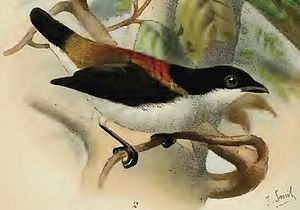Four-color mistletoe
| Four-color mistletoe | ||||||||||||
|---|---|---|---|---|---|---|---|---|---|---|---|---|

Four-color mistletoe ( Dicaeum quadricolor ) |
||||||||||||
| Systematics | ||||||||||||
|
||||||||||||
| Scientific name | ||||||||||||
| Dicaeum quadricolor | ||||||||||||
| ( Tweeddale , 1877) |
The Cebu Flowerpecker ( Dicaeum quadricolor ), also known as Cebu flower picker called, is a rare songbird from the family of Mistelfresser that on the Philippine island of Cebu endemic and by the IUCN threatened with extinction ( "critically endangered" ) is classified .
description
The four-color mistletoe reaches a size of 11 to 12 centimeters. The male is characterized by a large, triangular, scarlet to vermilion mantle spot. The lower back is ocher with a greenish tinge. The back, neck, sides of the head and neck, wings and tail are glossy blue-black. The underside is light yellow. Chin, mid-abdomen, armpits, under tail-coverts and under wing coverts are white. The flanks are washed out in light olive. In the female, the upper side is brown. The head is faintly olive-washed, the back, the wing covers and the outer flags of the arm wings are heavily olive-washed. The rump is almost completely olive yellow. The underside is gray-white with a faint olive-yellow tinge, which becomes lighter towards the middle of the abdomen and chest. The under wing-coverts, the armpits and the inner plumes of the quills are white.
Habitat and way of life
The four-color mistletoe is a forest dweller and occurs at altitudes of up to 500 meters. Its diet consists of the berries of belt flowers and small ripe fig fruits .
Danger
When it was first described scientifically in 1877 by Arthur Hay, 9th Marquess of Tweeddale , the four-color mistletoe was still considered relatively common. In the 1890s, Cebu's forests were severely cleared and its habitat in the Terra typica near Toledo City was completely destroyed. Between 1906 and 1992 it was considered extinct, until it was rediscovered by ornithologist Rob Timmins in a fragment of the forest near Tabunan. Today fewer than 100 individuals exist in the regions of Tabunan, Nug-As , Dalaguete and Mount Lantoy. In 1996, a strictly protected zone was created in Central Cebu National Park to protect the species from extinction.
literature
- Kennedy, RS, Gonzales PC, Dickinson EC, Miranda, Jr HC & Fisher TH: A Guide to the Birds of the Philippines . Oxford University Press, Oxford 2000, ISBN 0-19-854668-8
- Dieter Luther: The extinct birds of the world . Magdeburg 1986, 4th edition 1995, ISBN 3-89432-213-6
- Bournes, FS & Worcester, DC (1894): Preliminary notes on the birds and mammals collected by the Menage Scientific Expedition to the Philippine Islands . ( Online )
Web links
- BirdLife International: Species Factsheet - Dicaeum quadricolor
- Dicaeum quadricolor inthe IUCN Red List of Threatened Species 2016.3. Listed by: BirdLife International, 2016. Retrieved January 29, 2017.
- Threatened birds of Asia - Dicaeum quadricolor (PDF; 356 KB, English)
- Photos of bellows in the Smithsonian Institution
